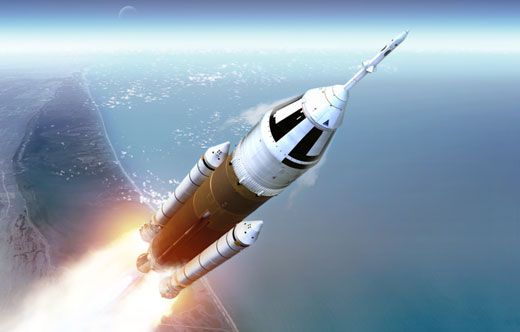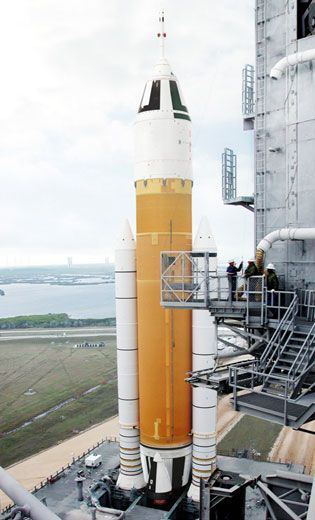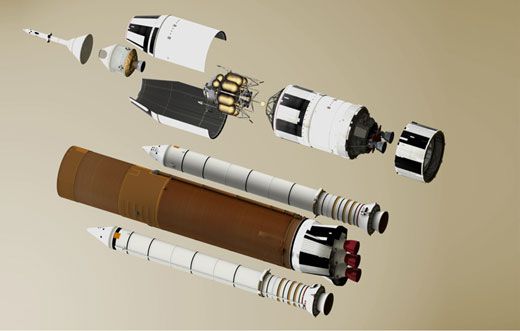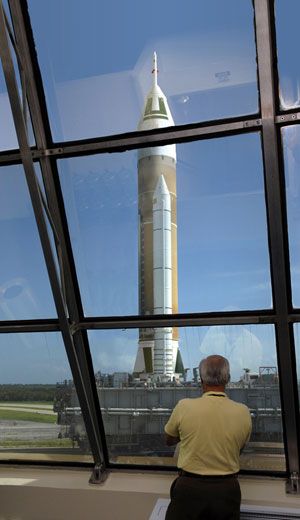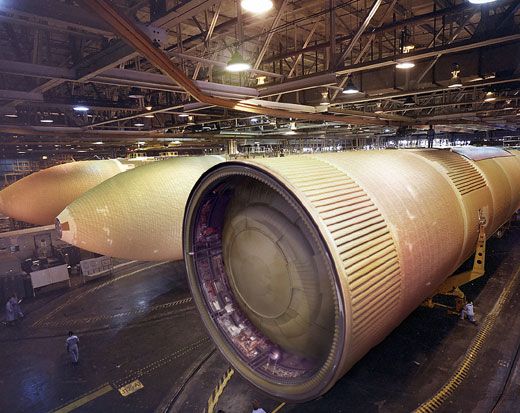End Run
A small band of rogue rocketeers takes on the NASA establishment.
/https://tf-cmsv2-smithsonianmag-media.s3.amazonaws.com/filer/directlauncher-flash.jpg)
The rocket is transformative, literally. On the web site, a space shuttle launches atop two pillars of flame gushing from solid rocket boosters, just as we’ve seen for the last quarter century. Then the video morphs into an animation that freezes and rotates the vehicle back toward you. Invisible hands take the shuttle stack apart, like a child mixing and matching a toy. And a new rocket, the Jupiter 232, takes shape, using the external fuel tank and the boosters, but without the familiar spaceplane.
In the upper left corner of the screen appear the words: “Direct v2.0: simpler, safer, sooner.”
That description is a matter of some debate between the web site’s creators and NASA. The animation is the work of Philip Metschan, a graphic designer and concept artist at Pixar Studios in California. He produced it about a year and a half ago using the same kind of software used for Hollywood movies like Jurassic Park, The Golden Compass, and The Incredible Hulk.
But he’s just the artist. His brother Stephen, he says, is the brains behind the concept, known as Stephen Metschan insists that Direct is a more elegant way to send astronauts to the moon than the launcher NASA now plans to build. The agency has been spending billions on a pair of new rockets, the Ares I and V, which he says are unnecessarily complicated and expensive, and which fail to adhere to a Congressional mandate to use shuttle-derived rockets to the fullest extent possible.
Stephen Metschan, with a handful of colleagues, is among the most vocal critics of the Ares design. He says he’s supported by 69 active NASA and contract engineers—mostly at the agency’s Marshall Space Flight Center in Alabama and Kennedy Space Center in Florida—who remain anonymous for fear of losing their jobs. At night and on weekends, the band of renegades keeps refining their Direct Launcher concept as an alternative to the Ares launchers. Should the political winds shift at NASA, Metschan thinks it’s still early enough in the program to switch to Direct, as much of the money spent on the moon program so far would still apply to his concept.
A decade ago, Metschan started his company, TeamVision Corporation, with a NASA Small Business Innovation Research grant. TeamVision makes Framework CT, an analysis tool that helps solve highly complex problems by sorting through millions of possibilities. Metschan soon found a meaty problem for the software: What’s the best way to convert the space shuttle’s existing parts into a design that will take astronauts to orbit and to the moon, with a new space capsule (called Orion) atop the vehicle, and with as few changes to the rest of the parts as possible?
One key advantage of Direct, say its creators, is that it uses the tried-and-true, four-segment version of the shuttle’s solid rocket boosters rather than a new, five-segment version required for Ares. Adding the extra segment has caused engineering headaches for NASA due to the increased shaking produced by what is, by far, the largest solid rocket the world has ever seen. If left undamped, this “thrust oscillation” would feel like a massive jackhammer for the astronauts riding on top of the Ares.
NASA discovered the problem early in the design phase, and says that it has a solution: installing about 200 large springs in the bottom end of the booster, and another 200 in the top end, between the booster and the second, liquid-fueled stage. Dampers beneath the astronauts’ couches should reduce residual oscillations to a tolerable level, letting astronauts reach out and toggle a switch during ascent.
Metschan says the plan won’t work, and that the agency is clinging stubbornly to its Ares design without giving other ideas a chance. “In any normal organization, this would have been put in the dust bin of history,” he says.
He and two colleagues—Ross Tierney, who owns a model rocket business in Florida, and Chuck Longton, who used to work for NASA on liquid-fueled engines—are the public faces of Direct Launcher. All three claim that the real problem at NASA is close-mindedness, particularly on the part of Administrator Mike Griffin. To Metschan, it seemed that Griffin came to NASA in 2005 having already decided that Ares I and V were the only options. Direct Launcher, they say, never got a fair hearing.
“If your plan didn’t include Ares I,” says Metschan, “then your case was dead on arrival.”
NASA shrugs at such accusations.
“NASA has assessed over 1,700 launch vehicle options since the conclusion of ESAS [the Exploration Systems Architecture Study] in the summer of 2005,” says Steve Cook, NASA’s Ares I program manager. “The primary issue with all of the ‘Direct’ options, including the most recent variation released in late June, 2008, is that they fall short of our performance requirements. If a system can’t pass this primary gate, we do not perform more detailed analyses.”
Cook says the Direct proponents offer no methodology or data to support their claims of cost savings on their design for the central fuel tank; and that developing Jupiter’s core system, even with the fuel tank derived from the shuttle’s tank, would be far more expensive than the Direct proponents promise.
Furthermore, he says, Ares I and V are well under way, with Ares I having just concluded its Preliminary Design Review. The thrust oscillation problems, Cook admits, still need to be addressed in a follow-on review next summer, “to mature the design solution.” But he warns that restarting the program now would waste billions of dollars spent developing the integrated Ares I stack, including redoing 6,000 hours of wind tunnel tests.
In Government Accountability Office noted the technical risks facing the Ares program, but was not as pessimistic as Metschan about the chances of solving them: “We do not know yet whether the architecture and design solutions selected by NASA will work as intended,” concluded the authors.
As for who’s right, in NASA’s view it’s the space agency’s 3,700 team members in over 200 organizations across the country against Direct Launcher’s 69 anonymous engineers.
Metschan and his team intend to keep working on their plans anyway, in case Ares fails or Griffin leaves NASA. At least one recent development has worked in Direct’s favor. Russia’s military incursion into Georgia stirred concerns of U.S. dependency on Soyuz vehicles and led several influential lawmakers to press the White House to keep the shuttle flying past 2010. That in turn led NASA to halt plans to begin ripping out the tooling for the shuttle’s external tank fabrication at the Michoud facility near New Orleans. Direct Launcher would use the same 8.4-meter fuel tanks as the current shuttle. Ares V, on the other hand, would use a 10-meter tank that requires all new tooling. Once NASA converts to manufacturing the larger size, Direct Launcher becomes a dead option.
Is it common to have such a determined group of engineers working on alternative plans at NASA?
“Oh sure,” says Roger Launius, senior space history curator at the National Air and Space Museum and chief historian at NASA between 1990 and 2002. “You’ve always got hobby shops. People are always working on stuff on the side. I remember a great example: the lifting body people. Back in the ’60s they couldn’t get funding. The focus was all on Apollo. All they got was about $20,000 at first. They built the M2-F1 [lifting body] out of plywood. Went down to L.A. and bought an old Pontiac, suped it up so it would do 180, and used it as a tow vehicle.”
Launius regards the parallel effort as a natural wellspring of activity from a creative bunch.
“You got a bunch of smart people who are used to solving problems,” he says. “Nothing to be surprised at. It’s really something to applaud. The question is, though, is this reality or is it pipe dreams? We’ll see. It’s easier to draw this stuff than it is to build and fly it.”
